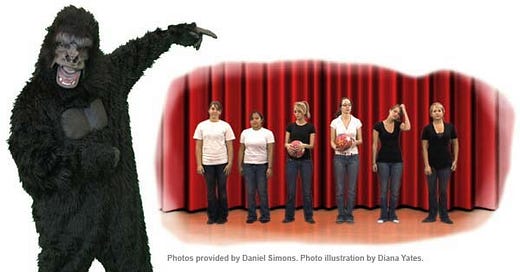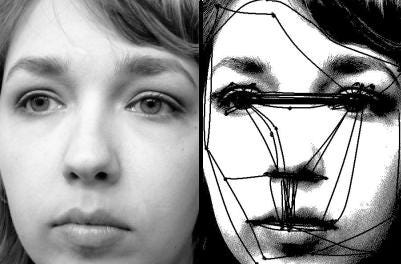#84: Change is the start of your story
3 things that will help you capture the attention of your crowd
Birds see the world with six colors. Mantis shrimps see it in fifteen. The human mind settles for three but the area of the eye that reads the world in HD is tiny. 1.2mm. Color vision ends 20 - 30 degrees on either side of you and focus at the end of your thumb if you hold your arm up straight. Everything else? That is a black and white fuzzy muss with a huge black, orange-sized hole dead center where the optic nerve goes.
But how do we see? The answer is we don’t. The 4K, high-definition color ‘reality’ we ‘see’ is nothing more than a dream. A perfect illusion made of imperfect data. The most well-known study that demonstrates an aspect of this involves a video of a room full of people bouncing balls and a gorilla. Participants in the study were asked to watch closely and count how many times the balls was bounced between them. More than half didn’t see the man dressed in a gorilla suit who walked right up to the camera, beat his chest three times, and then just walked out. His total screen time was a whopping 9 seconds.
Let’s get practical. Tired of people not listening to your stories? Classrooms filled with teenagers whose attention you can’t capture at the end of a hot day? Diner parties where your turn falls flat? Boardrooms filled with people that aren’t impacted when you talk?
The answer to changing that starts with understanding something really simple about the human mind. Change. Change is the only real starting point for our attention and it has a lot to do with the human eye. Neuroscientist Sophie Scott said, “Our perceptual systems (aka eyes) don’t work unless there is change”. It’s not programming, but you wouldn’t be wrong for calling it an immovable precedent that’s only getting stronger thanks to TikTok, YouTube Shorts, and Meta. Big idea, unless there is a change in your story you can be almost guaranteed your ‘data’ will be left sitting in that grey mush on the peripheries of your mind.
It is only by focusing on change that the brain creates a realistic visual model of the world around us that we perceive as reality. It does this thanks to the fastest muscle in the body responsible for moving that 1.2mm HD sensor in our eye. It moves so fast it can focus the best part of our retina on up to five different things every second. And how does the brain subconsciously choose where to point its eyes every five seconds? You guessed it. Things that change around us.
Given this almost unbreakable law here are three simple ways to tell a better story:
One: Nelson Mandela was born in 1918 in the village of Mvezo in the Eastern Cape. It was a rural world. His name was Rolihlahla, or ‘troublemaker’. He lived in a mud hut and herded cows… Yawn. Stories don’t begin at the beginning, they begin at the start of change. Let’s try again: On the bustling streets of Johannesburg, a young, handsome Mandela strutted. His fedora cresting the back of his head, tie untucked, jacket slung casually over his shoulder after a long day at Mandela and Tambo Attorneys. If gods could sing they would have, across the street walked a woman named Winne…
Two: “If it bleeds, it leads”, that’s what a political communicator with 20 years of experience told me last week as we prepare ourselves to tell the DA story heading into the national election in May 2024. Why also goes back to that 1.2mm at the center of your retina. The primary purpose of our eyes is to keep us alive. There is a reason why Verimark adverts still work. We’re afraid. Desperately so. Increasingly so. Haunted by physical danger and existential dread. We live in one of the most dangerous countries in the world and without an acute awareness of changes in our environment is it only just a matter of time until we are highjacked, hustled or mugged.
Apply this is easy, clearly. Send a WhatsApp of someone being shot and you win; attention is grabbed, and you have successfully told a story people will listen to. Applying this constructively is challenging. My approach is to only use fear in stories if I am the protagonist. This gives me control to lift the nose and make a point that serves rather than destroys. “I asked him if needed tools… He spun around with a copper pipe he’d just ripped from my wall, it was still dripping in his hands. He was a big man, sheepish, yet scary as hell. Weird combination. After a while of just staring at me he said he did in fact need tools and was working for Mr Naidoo in unit six. Perfect I thought, now I know I am really in trouble, there’s no Mr Naidoo in unit six… So I invited him to the tool room and ushered him in first. The kick on his bump was pretty well-placed. He flew forward and fell on a pile of boxes while I slammed the flimsy, borer-eaten door shut starting to scream for help... Fellow members of the body corporate, it’s obvious, unless we address our lack of security this will remain our horrific reality”.
Three: Read the room. The gorilla study shows that even in the face of hilarious change the brain has limited processing capacity. Sometimes the best start to a story is not to start at all.
I hope you have the most blessed week.






